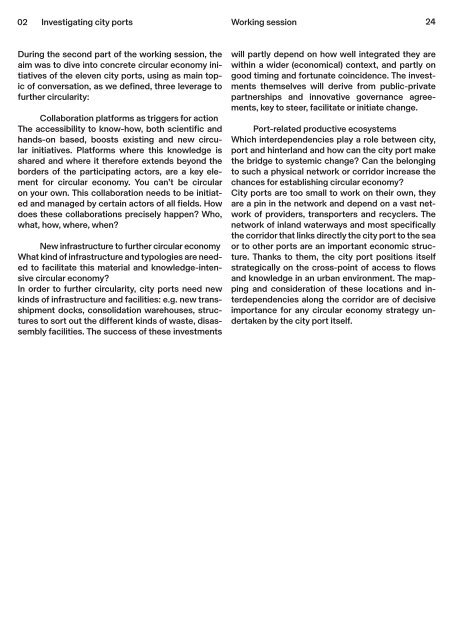Circular City Ports - Workbook
You also want an ePaper? Increase the reach of your titles
YUMPU automatically turns print PDFs into web optimized ePapers that Google loves.
02 Investigating city ports Working session<br />
24<br />
During the second part of the working session, the<br />
aim was to dive into concrete circular economy initiatives<br />
of the eleven city ports, using as main topic<br />
of conversation, as we defined, three leverage to<br />
further circularity:<br />
Collaboration platforms as triggers for action<br />
The accessibility to know-how, both scientific and<br />
hands-on based, boosts existing and new circular<br />
initiatives. Platforms where this knowledge is<br />
shared and where it therefore extends beyond the<br />
borders of the participating actors, are a key element<br />
for circular economy. You can’t be circular<br />
on your own. This collaboration needs to be initiated<br />
and managed by certain actors of all fields. How<br />
does these collaborations precisely happen? Who,<br />
what, how, where, when?<br />
New infrastructure to further circular economy<br />
What kind of infrastructure and typologies are needed<br />
to facilitate this material and knowledge-intensive<br />
circular economy?<br />
In order to further circularity, city ports need new<br />
kinds of infrastructure and facilities: e.g. new transshipment<br />
docks, consolidation warehouses, structures<br />
to sort out the different kinds of waste, disassembly<br />
facilities. The success of these investments<br />
will partly depend on how well integrated they are<br />
within a wider (economical) context, and partly on<br />
good timing and fortunate coincidence. The investments<br />
themselves will derive from public-private<br />
partnerships and innovative governance agreements,<br />
key to steer, facilitate or initiate change.<br />
Port-related productive ecosystems<br />
Which interdependencies play a role between city,<br />
port and hinterland and how can the city port make<br />
the bridge to systemic change? Can the belonging<br />
to such a physical network or corridor increase the<br />
chances for establishing circular economy?<br />
<strong>City</strong> ports are too small to work on their own, they<br />
are a pin in the network and depend on a vast network<br />
of providers, transporters and recyclers. The<br />
network of inland waterways and most specifically<br />
the corridor that links directly the city port to the sea<br />
or to other ports are an important economic structure.<br />
Thanks to them, the city port positions itself<br />
strategically on the cross-point of access to flows<br />
and knowledge in an urban environment. The mapping<br />
and consideration of these locations and interdependencies<br />
along the corridor are of decisive<br />
importance for any circular economy strategy undertaken<br />
by the city port itself.


















